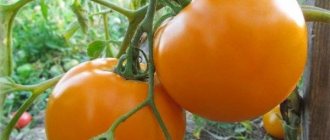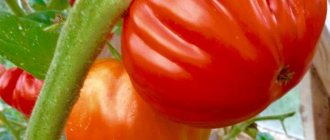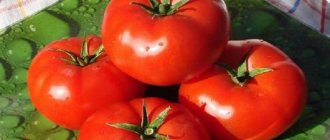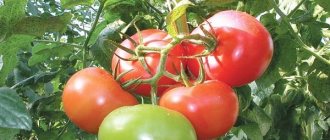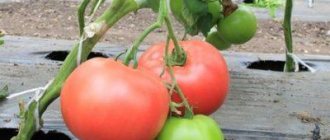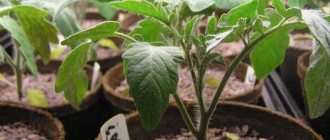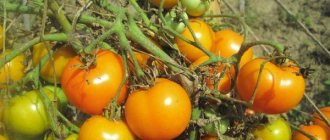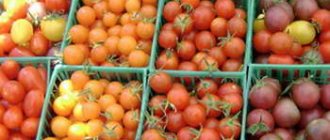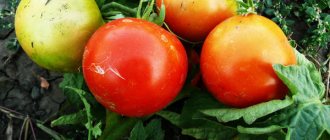Tomato Children's Joy will appeal not only to children, but also to discerning gourmets. A delightful variety suitable for professionals and beginners, it has simple agricultural technology. Entered into the State Register in 2011.
| Height | Landing location | Ripening time | Fruit color | Fruit size | Origin | Fruit shape |
| short | Greenhouse, Open ground | Ultra early | Reds | Average | Variety | Plum-shaped or oval |
Tomato Children's joy
The tomato variety Children's Sweetness is excellent for growing in summer cottages. Thanks to the early ripening of the variety, it is possible to enjoy the taste of these wonderful fruits already in the middle of summer. In 2011 it was included in the State Register.
Characteristics and description of the tomato variety Children's Joy
This is an early variety that has small bushes that grow no more than 60 cm in length. The weight of the fruit is up to 120 g. The tomatoes are rounded and elongated, bright red in color with scarlet sugar pulp and dense skin.
Due to the short growing season, this variety can be planted in open ground or in greenhouses using both seedlings and seeds. Fruits can be harvested within 3 months after germination.
This species is intended for cultivation throughout Russia and other countries.
Tomato Children's joy
Important! The Children's Sweet variety is not susceptible to tomato diseases that are often exposed to diseases.
Methods of growing tomatoes
Despite the presence of immunity to diseases, it is recommended to treat the seeds with a solution of potassium permanganate before sowing: 1 g of potassium permanganate per 100 ml of water.
Landing rules
After soaking for 25 minutes, rinse the seeds with clean water.
In the beds prepared in advance, make holes no more than 2 cm deep.
Holes for planting tomatoes
It is advisable to treat the holes with Fitosporin before sowing. This is an antibacterial agent that prevents various diseases of tomatoes. The solution is prepared as follows: for 10 liters of water 1 tbsp. spoon of the product. This amount is intended to process 1 m2.
Important! The sowing density of seeds should not exceed 6 seeds per 1 m2. After sowing, water the ridge generously, and then irrigate no more than 2 times a week.
After sowing, water the ridge generously, and then irrigate no more than 2 times a week.
Periodically, you need to weed and loosen the soil under the tomatoes to saturate the plants with the missing oxygen.
Periodically you need to weed and loosen the soil under the tomatoes.
On a note! During the growth period, during flowering and fruit formation, tying and fertilizing with potassium-phosphorus fertilizers is necessary to increase productivity.
Despite its determinacy, the Children's Sweet variety is quite fertile and it is possible to harvest up to 6 kg of tomatoes from 1 m2. And harvesting can be done already in early July.
Tomatoes of the Children's Sweet variety, having a small fruit size, are ideal for canning. And the juicy, moderately fleshy pulp is suitable for cooking:
Baby Joy is perfect for making purees and gravy
Advantages and disadvantages
Using high-quality seeds for sowing, you can get a bountiful, wonderful harvest with the following characteristics:
- Thanks to their thick skin, the fruits are perfectly resistant to transportation over long distances.
- The shelf life of the fruit is up to 2 months.
- Super early ripening.
- Fruits with very juicy and tasty moderately fleshy pulp.
- Disease resistance.
- Unpretentious in care.
- Possibility of planting seeds directly into the garden plot.
- Suitable for any climatic conditions.
Tomato fruits Children's joy
The disadvantage of this variety is that the stems are rather brittle and require constant tying. Obviously, the advantages more than cover this disadvantage. And thanks to these advantages, many gardeners prefer to grow the Child's Joy tomato.
Some information about the plant
The characteristics and description of the variety are as follows:
- The fruits ripen 90-104 days after planting the seedlings in a permanent place.
- The height of the Child's Joy bush varies between 200-250 cm. To prevent the branches of the plant from breaking off from the weight of the berries, they are tied to strong supports.
- The tomato inflorescence is simple.
- The bushes have an average number of leaves, colored green.
- The fruits have a spherical shape. They are painted red.
- The weight of tomatoes ranges from 20 to 30 g. The pulp inside has increased density. There are 2-3 seed chambers on one tomato.
Read also: Grapes new gift to Zaporozhye variety description photo
That part of the farmers who planted and grew Children's Joy points out some shortcomings of the variety. Plant bushes are demanding in terms of formation. With incorrect agricultural technology, you can lose up to 30% of the harvest.
Every year you have to buy Children’s Joy seeds, since it is impossible to germinate them yourself due to the loss of the plant’s genetic qualities.
Reviews from gardeners who planted the described tomato show that up to 1500 g of fruit can be obtained from each bush. The average yield of the variety is 5-6 kg of berries per 1 m² of bed.
Due to early ripening, plants have time to bear fruit before late blight develops. But gardeners point out that most often Children's Joy gets sick with blossom-end rot and similar diseases.
The tomato variety Children's Sweetness is excellent for growing in summer cottages. Thanks to the early ripening of the variety, it is possible to enjoy the taste of these wonderful fruits already in the middle of summer. In 2011 it was included in the State Register.
Possible diseases and pest damage
Tomatoes of the Sensei variety have excellent immunity to a huge number of tomato diseases. However, summer residents who regularly grow this variety recommend taking preventive measures that completely eliminate the risk of damage to the plant.
To do this, you need to regularly remove all weeds from the beds. If cultivation is carried out in a greenhouse, it should be regularly ventilated, and the soil and structure should be treated with specialized antifungal drugs.
Sensei tomato foliage should be inspected regularly to prevent insect damage. When pests appear, it is necessary to begin combating them as early as possible. To eliminate slugs, you can use ammonia: the pest is removed from the leaf, and then the affected area is wiped with a solution of ammonia.
If tomatoes are attacked by flying pests, it is necessary to treat them with specialized chemicals.
Despite the fact that Sensei tomatoes were registered not so long ago, tomatoes are already very popular among summer residents. Such demand is determined by obtaining a rich harvest that has an attractive appearance, attractive aroma and excellent taste.
This variety is especially popular among residents living in the North. This is due to the fact that such an early ripening variety allows the tomatoes to ripen and acquire a rich crimson hue in the shortest possible time. Those tomatoes that have not had time to ripen are perfectly stored at home when placed in a dry, dark place and ripen when placed in the light.
Transplantation into the ground
According to the description of the tomato variety, Children's Sweetness is recommended for growing under film covers, where it is planted in May. Also, the crop can be transplanted into open ground when weather permits. Typically, the season for gardening with tomatoes begins in late May - early June, depending on the climate of the region.
Before transplanting seedlings into open or protected ground, it must be hardened off so that it gets used to new environmental conditions. This way, “moving” will bring her less stress. Plants in pots begin to be moved to an open balcony or street about a week before transplanting. Staying in the fresh air is gradually increased, starting from 30-40 minutes. As a result, the tomatoes will be outside all day. And if there is a heated greenhouse, then it’s night.
Related article:
Tomato Black Elephant - description and characteristics of a mid-season variety
Tomato Children's sweetness is planted in fertile aerated soil. If planting is done in open ground, it is recommended to place the tomatoes in high beds that are well heated by the sun. The day before transplanting, plants in pots are watered generously. This will make it easier to remove the earthen ball from the container and give the bushes a boost of energy before the upcoming stressful procedure.
Despite the fact that the tomato bush is determinate, it needs support. The stem often cannot support the weight of ripe and ripening fruits. Therefore, the tomato plantation must be placed either next to a trellis, or the plant must be tied to a stick about 1 m high.
The bed is spilled with water and a hole is dug in it, in which the entire earth ball with the root system of tomatoes will fit. The bush is carefully removed from the pot and placed in the hole using the transfer method. Drop well and water again.
Related article:
What are standard tomatoes
The planting pattern for Children's sweets is 40x50 cm. That is, there should be an interval of at least 40 cm between the bushes, and 50 cm between the rows. As a result, the originator recommends planting no more than 6 plants per 1 m2.
Heat-resistant varieties for greenhouses
For greenhouses in the southern regions of the country, only heat-resistant varieties of tomatoes are chosen. Even with constant ventilation of the greenhouse, on hot days the temperature in the buildings exceeds +30*C. Plants that are not zoned drop their ovaries, the leaves get burned, and the fruits become small and deformed.
Virtuoso
A productive hybrid, semi-determinate with a growing season of 98-113 days. The average length of the bushes is 1.4-1.7 m. 6-7 kg of vegetables are collected from one bush. The fruits are slightly ribbed, flat-round, red in color with a sweet taste. The weight of one tomato is 150 g.
In the southern regions, the variety adapts well to weather conditions, to differences in night and day temperatures. Virtuosos are grown through seedlings. Seeds are sown 40 days before transplanting into a greenhouse. In the greenhouse, seedlings are planted according to the scheme - 40 cm by 60 cm. The bushes are formed into 1 stem; tall plants need support and a garter. The hybrid is resistant to tobacco mosaic, fusarium, and cladosporiosis.
Kostroma
Semi-determinate hybrid, fruits ripen 100-110 days after sowing. The plant grows up to 2 m in height. Productivity is 15-20 kg per square meter; up to 5 kg of vegetables are harvested from one bush. Tomatoes bear fruit until the first frost.
Fruit characteristics:
- shape – round, tomatoes are ribbed near the stalk;
- color – red;
- taste – sweet and sour, tomato;
- weight – 80-140 g;
- used in canning, making juices and tomato paste.
Babylon
Tomato Babylon is a large-fruited, heat-resistant, indeterminate hybrid. Mid-season tomatoes ripen 120-140 days after germination. The plant is vigorous, the leaves are medium sized. The inflorescence consists of 6 flowers. The hybrid is resistant to mosaic, fusarium, nematode, and tolerates transportation well.
Dense fruits have 3-4 seed chambers. The color of the tomatoes is red, one fruit weighs 150-180 grams. In the photo and description you can see large, beautiful round tomatoes.
Alcazar
The hybrid is indeterminate with powerful roots, the main shoot does not thin out, and can withstand the fruit load well. Alcazar is a mid-early variety; tomatoes ripen 110-115 days after planting. The stem grows all season long, the foliage is large and dark green.
Even in hot weather, plants form new ovaries. The fruits are round, equal in size, and do not crack. Tomato weight – 130-150 g. The hybrid is resistant to blossom end rot and pathogenic flora.
Margarita
Margarita tomatoes are a hybrid variety with a growing season of 95-105 days. The flower raceme consists of 6-8 flowers and grows above the 9th leaf. The height of the bushes is up to 1.8 m. The seedlings are planted in a greenhouse according to a pattern of 40 cm by 50 cm.
The fruits are large, red, weighing 130-160 g. The taste is sweet and sour, the shape is round. Up to 4 kg of vegetables are picked from one plant. Margarita is resistant to tobacco mosaic, cladosporiosis, and fusarium.
Important!
To achieve good yield, the plant is formed into one stem.
Chelbas
The hybrid is indeterminate, fruiting occurs on days 110-117. The variety is recommended for cultivation in greenhouse conditions in the south of the country. The inflorescence consists of 5-7 flowers. Ovaries form in any weather; Chelbas bears fruit even in hot weather. It is known far beyond Russia; it is grown in Iran and Egypt.
The fruits weigh 110-130 grams, they have fleshy pulp, and can be stored in a cool place for up to 40 days. Tomatoes do not crack and can be easily transported over long distances. The hybrid is disease-resistant and nematode-resistant. The scheme for planting seedlings is 50 cm by 40 cm. 3-4 plants are grown on 1 square. Productivity – 13-15 kg per square meter. m.
Characteristics of the tomato variety Andreevsky Surprise
Tomato Andreevsky surprise produces beautiful and large pink tomatoes. This variety is loved by farmers for its fruit taste and disease resistance. Tomatoes are grown in open ground and in greenhouses.
Characteristics of the tomato variety Andreevsky Surprise
Caring for the Andreevsky Surprise tomato is standard; the main thing is to provide optimal conditions for the seedlings.
Description of the variety
The variety takes root well in the middle zone and northern regions, where vegetables are grown mainly in greenhouse conditions.
Varietal characteristics and description of the tomato Andreevsky Surprise:
- The bush is indeterminate. It reaches a height of about 2 m. The central stem is powerful.
- The ripening period is medium-late. The harvest can be harvested 10-120 days after sowing the seeds for seedlings.
- Productivity is low. From 1 sq. m of beds harvest 8 kg of fruit.
- High resistance to late blight.
Trellis growing of tomatoes is recommended. A powerful bush with heavy fruits needs strong support.
Description of fruits
Andreevsky Surprise tomatoes were highly appreciated by experts in the field of vegetable growing. The description of the St. Andrew's Surprise tomato will help you understand why:
- The fruits are flat-round.
- The color of the ripe fruit is pink-red.
- The average weight of one tomato is 150-200 g when grown in open ground. In greenhouse conditions, it is possible to obtain fruits weighing up to 500 g.
- The pulp is fleshy and juicy.
- The taste of the fruit is sweet and sour, pleasant.
The fruits are eaten mainly fresh. They go well with other vegetables in fresh summer salads. Pasta, juices, adjika and other sauces are also prepared from tomatoes.
The disadvantage of tomatoes is their tendency to crack. This significantly reduces the assessment of commercial qualities. The fruits do not tolerate transportation very well.
Caring for the plant is easy
Seed material for the Andreevsky Surprise tomato variety is not difficult to find.
Planting seeds
Seeds for seedlings are sown in mid-March or early April. For good survival, the seeds are hardened. A week before sowing, they are placed in a tub with sand and placed in the refrigerator or cellar.
Planting seedlings consists of the following stages:
- The bottom of the tub is lined with drainage material (river sand, broken brick).
- A mixture of garden soil, sand, neutral peat and manure is poured (ratio 3:1:1:1).
- Make several parallel grooves 2 cm deep in the surface layer of soil. The distance between the grooves is 3-4 cm.
- Place the seeds in the grooves at a distance of 2-3 cm from each other and cover with earth.
The top of the planting container is covered with transparent polyethylene or glass. This provides the seeds with the necessary microclimate. The shelter is ventilated once a day.
Seedling care
The soil with crops is watered as it dries. The soil should not be allowed to dry out. The sprouts are picked when the first true 2-3 leaves appear.
What is important to consider when caring for seedlings:
- abundant watering;
- fertilizing with manure 2-3 weeks after the sprouts appear;
- optional additional lighting.
The variety's sprouts need enough natural light, which enters the room from the street through the windows. A week before the planned planting in the garden, the intensity of watering is increased.
Planting seedlings
Features of planting seedlings in the ground:
- planting pattern - 70 x 30 cm;
- per 1 sq. m beds plant no more than 4 bushes.
The bed for planting is prepared in the fall. The soil is dug up half a meter and compost is added. The planting hole is well watered before planting the seedling. When the soil dries, the roots of the seedling are placed in the groove. The root collar is buried 5 cm, the plant is covered with soil, trampled down, and mulched with dry straw. The bottom 2 leaves are carefully removed.
Tomato care
To ripen the fruit, the variety needs good soil moisture, regular fertilizing and sunlight.
Plant care rules:
- Stepsonning. The bush is best formed into 1-2 stems.
- Watering. Tomatoes need to be watered at the root, the watering intensity is 1 bucket per bush once a week.
- Feeding. Fertilizers are applied every 3 weeks. Organic matter is alternated with mineral fertilizers. For fruit ripening, potassium supplements are needed.
The best varieties of tomatoes for the south of Russia
Varieties of tomatoes have been developed for the southern regions of the Russian Federation, which can bear fruit outdoors in the hot summer. Tomatoes produce abundant harvests, fruits with excellent taste and good transportability.
Variety Generosity
Generosity tomatoes are grown in open soil. The variety has an early period of fruit ripening. Seeds are sown for seedlings in March. Tomatoes have a good taste and are used for salads, sauces and canning.
Characteristics of the variety
Tomatoes are bright red in color, round in shape with thick skin, green leaves. The variety is not prone to growing green mass. Tomatoes are resistant to diseases: septoria blight, macrosporiosis, stemphylliosis, verticillium blight. The plants are determinate, reaching a height of 50 cm. The first inflorescence is formed above the 6-7 leaf, then every 4 leaves.
Main characteristics:
- fruits weigh 60-80 g;
- The tomato has 6 seed chambers with small grains;
- juicy pulp – dry matter 4%;
- sugar content 2.5%;
- growing season 90-100 days;
- 3-4 brushes are tied on each stem;
- 6-8 kg of vegetables are harvested from 1 square meter.
Tips for growing the Generosity variety
Seeds for seedlings are planted from March 20 to April 10. They are buried 1.5 cm into the soil. Sprinkle soil on top and water. Temperature for emergence of seedlings +22-+25*C. Sprouts sprout 7-8 days after sowing. There should be 12-14 hours of daylight for the full development of seedlings. The room needs to be ventilated; plants need fresh air.
Before transplanting into the garden, the seedlings are hardened off. Within 6-8 days, they are taken outside for a couple of hours, the seedlings get used to the air temperature and bright light. Seedlings are planted in the beds in May, there are no longer night frosts, the soil warms up to +16*C. In the fall, the soil is fertilized with potassium-phosphorus additives and compost is added. The scheme for planting seedlings is 40 cm by 60 cm. Drip irrigation is used as the soil dries. To reduce moisture evaporation, the soil should be mulched.
Advice!
For the first time after transplanting into the beds, the seedlings need to be shaded from bright sunlight.
Tomato New Kuban
The variety was bred at the Krasnodar Institute. Recommended for growing in open soil. Tomatoes are valued for their good transportability, resistance to infections and excellent taste.
Characteristics of tomato
Plants are determinate, medium in size with moderate branching. The height of the bush is 30-40 cm. An inflorescence with 4 flowers is formed above the 6th leaf. The fruits are large, heart-shaped, weighing 80-110 g. The color of the tomato is red, the surface of the skin is smooth. The number of nests in a tomato is 3-7 pieces. The tomatoes taste great. The dry matter content in fruits is 5-7%.
New to Kuban - a mid-season variety, the fruit ripening period is 140-170 days. Productivity per square meter is 2.5-7 kg. Tomatoes are resistant to late blight and macrosporiosis.
Advantages of the variety
The bushes are compact, which means you can grow 3-4 plants in one square plot. The fruits tolerate transportation well over long distances. Tomatoes do not crack. The variety tolerates drought and heat, and is disease resistant.
In the first two weeks after the start of fruiting, 20% of the total harvest is harvested. Vegetable harvesting takes place in September. On an industrial scale, 375-1030 centners of tomatoes are harvested from 1 hectare.
Tomato Pink Andromeda
The Pink Andromeda hybrid was registered in the State Register, its author is Alexey Mashtakov. A low-growing, determinate variety with ultra-early ripening, it is valued for its good taste and high yield.
Hybrid characteristics
Plant height is 50-70 cm. Fruiting occurs 85-90 days after the first shoots. The weight of one fruit is 100-120 g. The hybrid has high transportability of tomatoes.
The first flowers appear above the 5-6th leaf, then after 1-2 leaves. The brush consists of 4-8 tomatoes. The fruits have dense flesh, they are flat-round, pink or light crimson in color. There are 4-6 seed chambers. Tomatoes are made into puree, ketchup, tomato paste, and the juice is very thick.
Advantages and disadvantages of a hybrid
The yield of the variety in the south of the country is 5-9 kg per 1 sq. m. Pink Andromeda can also be grown in greenhouses, where it bears fruit well - up to 10 kg/sq. m., one plant produces 1-3 kg of fruit.
The fruits are large, all approximately the same size. You can collect tomatoes with brushes and grow plants without a garter. There are few stepsons growing, the bushes are limited in growth. The hybrid tolerates day and night temperature changes. Tomatoes are heat-resistant, but at temperatures above +30*C they can lose flowers and ovaries. The plants have short roots, so tomatoes should be constantly fed and watered.
Important!
The hybrid is prone to late blight infection; it is necessary to treat the soil and seeds before planting.
Agricultural technology
To correctly calculate the timing of sowing, the characteristic ripening period is used, which for Children's sweets is short, 80 - 90 days. The tomato is early, so seeds for seedlings can be planted in early April. At the end of May, 40-day-old seedlings can be transplanted into open ground.
A description of the planting scheme is given on the seed package. - recommends placing up to 6 bushes per square meter, maintaining an interval between plants of 40 cm, between rows - 50 cm. Summer care of tomatoes is usual, consists of watering, fertilizing, weeding.
Watering
It is better to water low-growing bushes in the morning. Make sure that drops of water do not fall on the stems or leaves. The optimal water temperature is 20 to 25 °C. It is better to let the liquid stand before watering. Rainwater brings more benefits when growing tomatoes. If it gets cold outside, watering should be stopped, and if watered, then with warmer water (30 °C).
Feeding
Nitrogen fertilizer, urea or ammonium nitrate must be applied once after replanting the Children's Sweets on the ridge. During the summer, feed with phosphorus-potassium fertilizers, not forgetting about other microelements: magnesium, boron, iron. Plant leaf parsley next to the bushes of Children's Sweets - there will be more sweetness in the tomatoes.
Description of the tomato variety My Joy, features of cultivation and care
Gardeners who choose varieties for making juices and pastes should pay attention to the My Joy tomato. During selection, the hybrid is endowed with excellent taste and high yield
What other benefits does this variety of tomatoes have?
Description
My joy is an early ripening determinate variety. From the moment of emergence of seedlings to the collection of the first fruits, 93–95 days pass. The height of the medium-leafed bush is 90–110 cm. Due to this height and the large number of fruits, the plant needs to be attached to a support and pinched.
The first inflorescence is formed above 6–7 leaves and is repeated after 1–2 leaves. Unripe fruits are light green, mature ones are deep red. The shape of the tomato My Joy f1 is round, the skin is smooth. With proper care, the fruit weighs 80–150 g. In some cases, tomatoes grow up to 200–300 g. The pulp is juicy and sweet. Fruit ripening is consistent. In a garden bed with 1 sq. m manages to collect 4.7 kg of tomatoes, in the greenhouse - 13.9 kg.
Thanks to its structure, the vegetable has a good presentation and can easily withstand long-term transportation. The variety can be used for cultivation in open and closed ground. The fruits are suitable for fresh consumption and processing into tomato juices and pastes.
The main advantage of the My Joy f1 variety over other varieties whose fruits are intended for processing is high immunity to tobacco mosaic, fusarium and alternaria. In addition, the culture tolerates high temperatures well. As you can see, the description of the variety is very impressive. What conditions does the plant need to provide?
Features of cultivation
Caring for the Tomato Variety My Joy is no different from other types of vegetable crops. To grow healthy seedlings and reap a generous harvest, you need to carry out the following manipulations:
Sowing. To obtain seedlings, seeds are sown in containers 50–55 days before planting in a permanent place. The optimal depth of the furrows is 2–3 cm. To prevent the soil from drying out, cover the container with glass or film on top. As soon as the sprouts appear, the shelter is gradually removed. Transfer. If necessary, at the age of 2–3 true leaves, seedlings are plucked. Tomatoes are ready for planting in open ground after the formation of 5–6 leaves. Treatment against diseases and pests. Since the characteristics and description of the variety contain information about the crop’s resistance to diseases, it is rarely necessary to process the bushes while ensuring the right conditions. Those who planted these tomatoes note that for prevention purposes, the plants should be sprayed with Bordeaux mixture at intervals of 2 weeks. Watering. Tomatoes grow best in moderately moist soil. In hot weather, the crop is watered once every 7 days. In case of regular precipitation, the frequency is reduced. Feeding. Mineral and organic fertilizers are applied to the bushes 3 times. The main rule for successful feeding of tomatoes is that overfeeding should not be allowed.
Nitrogen is applied especially carefully, since an excess of the substance provokes the growth of greenery to the detriment of the fruits.
Planting and care
It is best to grow “Children's Joy” tomatoes using the seedling method. Seeds are planted in prepared soil mixture 2 months before planting in a permanent place. If grown in a greenhouse, you can plant in March, if in open ground, then in April.
In phase 2 of this leaf, a dive is carried out. Before planting in the ground, 1–2 weeks before, the seedlings are hardened off.
Tomatoes must be pinched and tied to supports.
You can place up to 4 plants per 1m2. Be sure to fertilize with complex fertilizer at least 2 times, during flowering and before the start of active ripening.
In order to grow a good harvest, simple agrotechnical requirements should be followed. This:
- Watering with warm water after sunset.
- Loosening.
- Weeding.
- Mulching.
Those who planted “Children's Joy” on their plot recommend forming tomatoes into two stems.
"Sweet Bunch"
Official information
It took only 1 year to conduct tests and introduce the variety into the register of breeding achievements of the Russian Federation. And in 2009, the variety was legalized under number 9153937.
Applicant and originator of the variety LLC Agrofirma Sedek, Moscow region, Domodedovo.
The variety is recommended for cultivation in all regions of the country under film greenhouse shelters and in open ground in private gardens of flower growers as an early ripening variety.
Of the entire series, only the “Sweet Bunch” variety has legal rights to exist. However, the market is filled with other “bunches”.
Characteristics of the variety
Considering the “Sweet Bunch” tomato, the characteristics and description of the variety indicate that the plant is indeterminate. The growth of the main shoot does not stop until we ourselves interrupt it. Often the plant reaches the height of a greenhouse and 1.8 m in open ground.
The leaf blade is large, dark green. The plant has good foliage.
Fetus
The tomatoes are round, smooth and dense. In full biological ripeness, uniform red color.
There are two nests. The seeds are small. Tomatoes weigh from 20 to 30 g, there is no uniformity in weight. Ripening is also not uniform, so the bunch initially does not have uniformity in color.
The taste quality is rated “good”, but those who have already grown tomatoes speak of a satisfactory taste, since they expected a sweet taste from a sweet bunch. The balance of organic acids and sugars is not organic enough and the sweetness is not felt.
The dense skin of a tomato protects the fruit well from cracking, both on the bushes and during heat treatment, but when eaten, you feel that it is extremely dense and “annoying.” Many vegetable growers, describing their impressions of the variety, consider the skin to be one of the stopping factors, and it is because of this feature that they refuse to grow tomatoes.
Use of commercial tomato
Tomato behaves well when canned with whole fruits. Having selected them according to color and size, you can fill them with both marinade and tomato juice.
Whole fruits, canned in tomato juice, are served in solyankas, and they serve not only as filling, but also as decoration.
The tomato does not burst during heat treatment. Some housewives, fearing that the fruits will lose their integrity, prick them with a needle, but there is no need to use this technique for the “Sweet Bunch” variety.
When using the fruit in fresh salads, many vegetable growers complain that they need to be blanched before serving because the skin is uneatable.
Productivity
The registration commission legalized the yield within 3.5 kg per square meter of film shelter area.
Those who have already grown tomatoes agree with the official figures and consider it completely unprofitable to occupy expensive land for such a barren variety.
Sustainability
When grown in a greenhouse, there are no special nuances with diseases and pests. When grown in open ground, and even under unfavorable weather conditions, reviews repeatedly say that the tomato is not resistant to late blight.
Advantages and disadvantages
Considering the advantages of the “Sweet Bunch” variety, the following points can be noted:
- early ripening and rapid delivery of fruits to the table;
- tomatoes tolerate heat treatment well while remaining intact.
The variety also has a number of significant disadvantages:
- low yield;
- the need for constant stepsoning;
- instability to late blight;
- satisfactory taste of fresh fruits;
- very thick skin.
Features of cultivation
Since the variety is tall, tying the shoot to supports is a natural step. However, the “Sweet Bunch” variety has the property of excessive formation of stepsons. To keep the tomato “within limits” it is necessary to regularly and timely remove the stepsons.
Maintaining a culture in two shoots is the most optimal. Increasing shoots does not provide a significant increase in yield.
Characteristics and description of the Superstar tomato, its advantages
The Superstar tomato is intended for growing indoors. The formation of bushes occurs to a certain height, and for uniform ripening of the fruits, excess foliage is regularly removed. Large tomatoes have excellent taste and are used fresh for making salads.
Benefits of tomato
The Superstar tomato variety belongs to European selection. It was bred as a salad fruit because the large fruits are not used for preservation.
The characteristics and description of the variety indicate the main value of the crop, which consists in the combination of rapid ripening and large fruits. An early ripening variety begins to bear fruit 3 months after germination. During the growing season, tall bushes are formed, reaching a height of 1.3-1.4 m.
Medium sized foliage. When growing crops, additional support is used to reduce the load on the stem and prevent it from being damaged under the weight of large fruits, the weight of which reaches 200-250 g.
The tomatoes are round in shape with a ribbed glossy surface. The color is bright red, the flesh is fleshy, with excellent taste. When cutting the fruit horizontally, 4-5 chambers with seeds are observed.
The yield of the variety is high, up to 3.5 kg of ripe tomatoes are harvested from 1 bush, and up to 12 kg of ripe tomatoes from 1 m². Tomatoes are disease-resistant because planted bushes bear fruit before nightshade crops are affected by fungi and other diseases.
The description of the variety lists high and stable yield as the main advantages of the crop. The plant easily adapts to conditions, which allows it to be grown in greenhouses and on balconies.
Agricultural cultivation technology
Sowing seeds for seedlings is carried out at the end of March. Plants dive in the phase of formation of 2 true leaves. The transfer of planting material to a permanent place is carried out in mid-May. Seedlings planted in protected soil give a healthy harvest in 1.5 months.
Bushes are planted according to the 40x50x70 cm pattern. During the growing season, the plant requires pinching and gartering of the stem.
Agrotechnical measures related to crop care consist of regular irrigation and periodic fertilizing with complex fertilizers according to the manufacturer’s scheme.
Opinions and recommendations of vegetable growers
Reviews from those gardeners who planted the Superstar variety in greenhouses indicate the absence of negative characteristics of tomatoes.
Olga Evdokimova, 49 years old, Adygeisk:
“Last season I planted the Superstar variety. I grew the seedlings myself from seeds at home. I poured the prepared soil into the pots, moistened it, placed the seeds at a distance from each other and covered them with an even layer of soil on top. I covered the pots with film, which I removed after germination. I transplanted it to a permanent location in mid-May. I was surprised by the size of the fruit. Despite the short growing season, the clusters ripened with simply gigantic fruits. They have an amazing aroma and sweet taste.”
Efim Krasilnikov, 57 years old, Belorechensk:
“My nephew grew the Superstar variety and advised me to experiment with the crop at my summer cottage. Having assessed the result of the work, I can note that the variety is very productive. The fruits ripened 85 days after sowing the seeds for seedlings. The bushes had to be tied up so as not to deform under the weight of the tomatoes. Tomatoes are tasty, fleshy, sweet in taste. The fruits are slightly ribbed and pleasant to pick from the bush. This variety perfectly combines the best characteristics of tomatoes.”
Harvest volume and application
If all care requirements are met, up to 1.5 kg of fruit can be obtained from one plant. The yield of 1 m2 is 6 kg.
Read also: When to add superphosphate to the soil in the fall
Tomatoes are versatile due to their shape. Therefore, they are used fresh, to decorate the festive table, and prepare salads.
Ideal for canning whole fruits. In addition, juices, tomato pastes and other winter preparations are prepared from it.
Characterizing “Bystrenka”
The description of this tomato includes such features as determinacy, compactness, and the already mentioned precocity. Representatives of this variety grow up to 75 cm; 85-90 days pass from sowing to ripening.
Ultra-early fruit readiness is an undeniable advantage, especially for regions where agricultural work can be risky. Therefore, many lovers of garden beds opt for low-growing early varieties: then they will be able to collect tomatoes for pickling in the last days of June.
As for the tomato bush, it cannot be called spreading. Its maximum height is 80 cm. However, tomatoes require tying to a support and pinching. The latter involves the elimination of lateral shoots arising from the leaf axils. The procedure will help to produce a better harvest and provides the necessary protection against diseases.
According to the recommendations of the manufacturers, the plants are formed into three stems. In the absence of a strong rush to obtain a harvest, it is better to carry out pinching for the first cluster. The tomato will ripen a little later, but its yield will not suffer in any way.
The main valuable characteristics of the variety are:
- Evenness of tomatoes;
- Consistently high productivity,
- Unforgettable pleasant taste;
- Parallel formation of all ovaries followed by fruiting;
- Resistance to various diseases inherent in tomato crops.
Thus, having early ripening, these tomatoes give their owners an excellent harvest before the appearance of such a scourge as late blight.
Tomato care
Daily care of tomatoes depends on the selected area. Tomatoes are planted in open ground from June; they barely reach 60 cm in height. Such plants do not require pinching or pruning of bushes.
In greenhouse conditions, the Summer Garden is grown from the second half of May. The height of the bush reaches 100-120 cm. And there are many such subtleties. If the rules are violated, the quality and quantity of tomatoes in the harvest decreases.
Watering
All tomatoes love moisture, and the Summer Garden variety is no exception. If recently planted seeds do not need to be watered, then young plants need high-quality watering every 3-4 days (less often in rainy weather).
Follow the watering rules. For example, irrigate the soil in the morning before 10 o'clock or in the evening after 18 o'clock. If you water the bushes in the heat, the liquid quickly evaporates and the root system does not receive moisture. The bushes first turn yellow, then dry out completely, which negatively affects the yield.
Before watering, check the soil under the bushes to make sure it is not cracking. Each plant requires 1.5-2 liters of settled water at room temperature. Water the plant strictly at the root, avoid strong pressure and the appearance of open holes.
Weeding and mulching
Summer Garden tomatoes do not tolerate the presence of perennial weeds, so weed the beds regularly. For rapid growth and ripening of tomatoes, hill up the plants every 2 weeks and control the appearance of weeds.
To retain moisture, after watering, apply a 5-8 cm layer of mulch made from sawdust or freshly cut grass to the ground near the trunk of the tomatoes. This is additional nutrition and protection for tomatoes. More about soil mulching is written here.
Loosening the soil
To prolong soil moisture, loosen it after each watering. Oxygen reaches the roots faster and the soil warms up better. It is advisable to perform this procedure once a week (at least), combined with weeding the beds and removing weeds.
For the first 2 weeks after planting Summer Garden tomatoes, loosen the soil to a depth of 15 cm. Later, no more than 8 cm in depth. Otherwise, the root system can be damaged and the young plant dies.
Bush formation and pinching
To ensure that the nutrients and moisture that the Summer Garden tomato receives do not go to ensuring the green crown of the bush, regularly carry out pinching. Remove young shoots on the bottom 6 leaves, do not allow them to grow to the sides.
Stepchildren that grow more than 5 cm in length reduce the yield of the variety. Statistics say that one shoot 15 cm long reduces the yield of a bush by 2-3 kg. Cut off the shoots at the root and monitor the appearance of new ones.
It is better to plant the Summer Garden bush in dry weather, preferably in the morning. With increased humidity, side shoots grow even faster, and the threat of harvest is renewed again.
Garter
Since tomatoes of this variety grow up to 50 cm in height, there is no need to garter the bush. The exception is when tomatoes ripen in greenhouse conditions and the plant grows up to 1 m in length. This moment is controlled by vegetable growers individually.
To help the plant, support the stem and protect it from breaking under the weight of the fruit, use wooden stakes as support. The optimal size is the length of the bush +20...+25 cm for deepening into the soil.
To avoid damaging the root system of tomatoes, install stakes at a distance of 10 cm from the plant itself. Tie the shoots with regular rope, but do not overtighten or limit the access of oxygen.
Feeding
After planting in open ground, tomatoes need fertilizing. The choice of composition depends on the fertility and composition of the soil in a particular area. From organic compounds, choose bird or cow droppings, green grass, and vegetable compost.
Among mineral fertilizers, potassium and magnesium phosphates, superphosphates, and urea are more suitable. In specialized stores you can buy tablets with microfertilizers; they are also widely popular as top dressing.
Recipe for time-tested fertilizer for 10 liters of water: mix 2 fertilizer tablets, 500 ml of cow dung and 1 tbsp. a spoonful of potassium sulfate. Dilute with water until smooth. There is 1 liter of fertilizer per plant; apply it under the root system.
